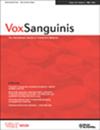Management of massive haemorrhage in transfusion medicine services in the Middle East and North Africa
IF 1.8
4区 医学
Q3 HEMATOLOGY
引用次数: 0
Abstract
Background and ObjectivesMassive transfusion protocols (MTPs) are critical in managing haemorrhage, yet their utilization varies. There is lack of data on the utilization of MTPs in the Middle East and North Africa (MENA) region. This study aims to assess the degree of utilization of MTPs in the region.Materials and MethodsWe conducted a survey to collect data on MTP use, inviting medical directors of transfusion services from various hospitals. Data were analysed to determine the prevalence of MTP utilization, their compositions, challenges in application and areas of future need.ResultsEighteen respondents participated, representing 11 countries in the region. Thirteen hospitals implemented MTP, and eight included paediatrics. Eleven institutions used more than one definition of massive haemorrhage, with the most common being ≥10 red blood cell (RBC) units transfused for adults and replacement of >50% total blood volume in paediatrics. The majority of sites with MTPs utilized 1:1:1 RBCs:platelets:plasma ratio (70%). Variations were observed in the types and blood groups of components used. Two sites utilized whole blood, while six are considering it for future use. Utilization of adjunctive agents and frequency of laboratory testing varied among the sites. Challenges included the lack of medical expertise in protocol development, adherence and paediatric application. The need assessment emphasized the need for developing regional guidelines, standardized protocols and training initiatives.ConclusionAlthough several hospitals have adopted MTPs, variations exist in activation criteria, blood product ratios and monitoring. Challenges include the lack of medical expertise, protocol adherence and addressing paediatric needs. Standardizing protocols, enhancing training and paediatric application are crucial for improving massive transfusion management in the region.中东和北非输血医疗服务机构对大出血的管理
背景和目的大量输血方案(MTP)对处理大出血至关重要,但其使用情况却各不相同。中东和北非地区缺乏有关 MTP 使用情况的数据。本研究旨在评估中东和北非地区对 MTP 的使用程度。我们对数据进行了分析,以确定 MTP 的使用率、构成、应用中的挑战和未来需要的领域。13 家医院实施了 MTP,其中 8 家包括儿科。有 11 家医院使用了一种以上的大出血定义,最常见的定义是成人输血量≥10 个红细胞 (RBC)单位,儿科则为总血量的 50%。大多数输血中心的红细胞、血小板和血浆比例为 1:1:1(70%)。所使用成分的类型和血型存在差异。两家医疗机构使用全血,而六家医疗机构正在考虑将来使用全血。各医疗点使用的辅助药物和实验室检测频率各不相同。面临的挑战包括在方案制定、遵守和儿科应用方面缺乏医学专业知识。需求评估强调了制定地区指南、标准化方案和培训计划的必要性。结论虽然已有多家医院采用了 MTP,但在启动标准、血液制品比例和监测方面仍存在差异。面临的挑战包括缺乏医疗专业知识、协议的遵守和满足儿科需求。标准化方案、加强培训和儿科应用对于改善该地区的大规模输血管理至关重要。
本文章由计算机程序翻译,如有差异,请以英文原文为准。
求助全文
约1分钟内获得全文
求助全文
来源期刊

Vox Sanguinis
医学-血液学
CiteScore
4.40
自引率
11.10%
发文量
156
审稿时长
6-12 weeks
期刊介绍:
Vox Sanguinis reports on important, novel developments in transfusion medicine. Original papers, reviews and international fora are published on all aspects of blood transfusion and tissue transplantation, comprising five main sections:
1) Transfusion - Transmitted Disease and its Prevention:
Identification and epidemiology of infectious agents transmissible by blood;
Bacterial contamination of blood components;
Donor recruitment and selection methods;
Pathogen inactivation.
2) Blood Component Collection and Production:
Blood collection methods and devices (including apheresis);
Plasma fractionation techniques and plasma derivatives;
Preparation of labile blood components;
Inventory management;
Hematopoietic progenitor cell collection and storage;
Collection and storage of tissues;
Quality management and good manufacturing practice;
Automation and information technology.
3) Transfusion Medicine and New Therapies:
Transfusion thresholds and audits;
Haemovigilance;
Clinical trials regarding appropriate haemotherapy;
Non-infectious adverse affects of transfusion;
Therapeutic apheresis;
Support of transplant patients;
Gene therapy and immunotherapy.
4) Immunohaematology and Immunogenetics:
Autoimmunity in haematology;
Alloimmunity of blood;
Pre-transfusion testing;
Immunodiagnostics;
Immunobiology;
Complement in immunohaematology;
Blood typing reagents;
Genetic markers of blood cells and serum proteins: polymorphisms and function;
Genetic markers and disease;
Parentage testing and forensic immunohaematology.
5) Cellular Therapy:
Cell-based therapies;
Stem cell sources;
Stem cell processing and storage;
Stem cell products;
Stem cell plasticity;
Regenerative medicine with cells;
Cellular immunotherapy;
Molecular therapy;
Gene therapy.
 求助内容:
求助内容: 应助结果提醒方式:
应助结果提醒方式:


